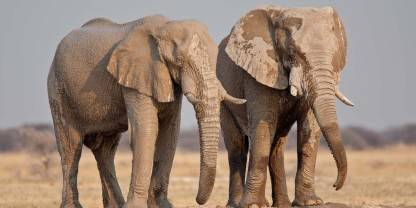Average Expert Rating
Rating Breakdown
Write a User ReviewNxai Pans: The Elusive Horizon
These salt pans, like contiguous Makgadikgadi to the south, are white worlds surrounded by islands of scrub and oases of greenery to provide some relief. There’s an epic quality to the landscape, a frontier world beyond the realm of human habitation with mirages shimmering above the white pans. The stand of vast baobabs known as Baines’ Baobabs is one of the Kalahari’s most evocative sights and a fine place to camp. Whenever I’ve visited, cheetahs and lions have been relatively easy to spot, making it one of the best places in Botswana to see the former. Elephants are also common, as are gemsbok (oryx) and impala. For the best wildlife watching, try the water holes north of South Camp, or the more remote Kgama Kgama Pan away
Read more
to the northwest – with few vehicles heading out this far, you’re far more likely to discover something interesting and then have it all to yourself.Salt Pans and Endless Sky
Nxai Pan is one of Botswana’s more remote parks and the game is certainly not as densely populated as in the likes of Chobe National Park, though there are still large numbers of elephants and plains game around, and we also saw lion, jackal and bat-eared fox during our short stay here.
Nxai Pan is a striking park too, with low, open savannah and sparse, moon-like salt pans occasionally punctuated by a ring of baobabs or a crop of acacias. In the dry season, game congregates around the small number of water holes. The light at dawn and dusk is spectacular; the heat in the middle of the day can be unforgiving.
Elephants are regular visitors to the generally well-maintained and shaded public camps. We were travelling through Nxai Pan with a trailer in tow, which made the 52km track of soft sand from the gate through to our camp a fairly slow and arduous undertaking.
Aside from its elephants, Nxai Pan is reputed for cheetah. Predators are said to be more active here in the wetter months, due to the higher numbers of migrating herbivores.
Baobabs, Big Cats and Salt Pans
Between Botswana's famous Kalahari and Okavango Delta, it's well worth stopping at the extraordinary network of salt pans known as the Makgadikgadi Pans. In this surreal area, heat haze shimmers above the cracked white pans, warping the horizon and the knotted shapes of baobab trees. There are several renowned baobabs here, including Baines' Baobabs, which drew me to the Nxai Pan section of Makgadikgadi. Rising starkly from the edge of a pan, the impressive clump of trees was immortalised in pictures painted by the intrepid artist Thomas Baines in 1862.
Large herds of animals migrate across the park, and seeing predators among the acacia trees in this bleached environment is a treat. On a guided safari from Planet Baobab near Gweta (recommended), we spotted a lioness leading her cubs towards zebras, springbok and wildebeest at a waterhole. The potential pray didn't seem bothered – they knew the lioness wouldn't risk leaving her young alone.
Where Cheetahs Race Through the Haze
Nxai Pan lies immediately north of the Makgadikgadi Pans and shares many of its characteristics, but the density of animals and plants here is greater. Like Makgadikgadi, it’s stark during the dry season and grassy after the rains, but the soil here is richer and the foliage considerably lusher. The park’s most recognised landmark is a ring of baobab trees made famous by the British naturalist Thomas Baines, who painted them in 1862.
An impressive variety of herbivores including elands, impalas, springboks, oryx, zebras, giraffes, blue wildebeest and red hartebeest use this small park as a grazing ground. Naturally, these attract predators, including cheetahs, for whom the even terrain serves as the perfect running track. In my opinion this is one of the best places to see cheetahs in the wild in southern Africa. It’s also an excellent place to see bat-eared foxes, jackals and brown hyenas.

